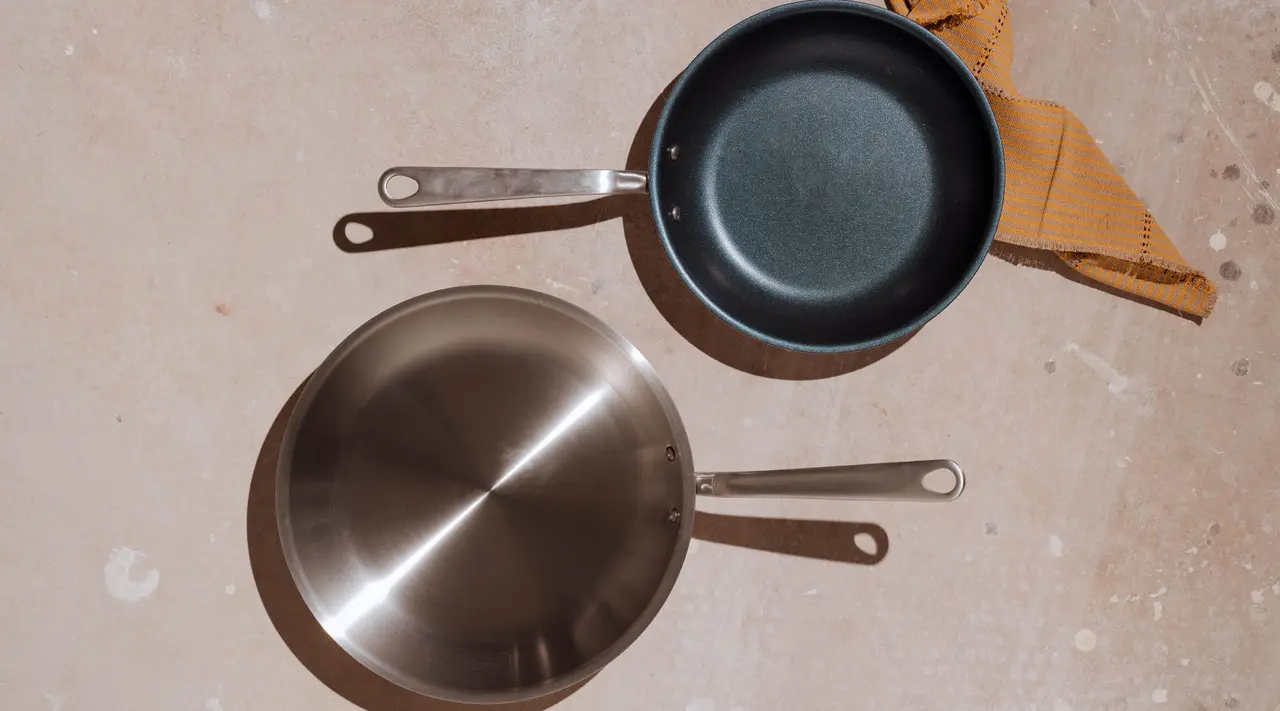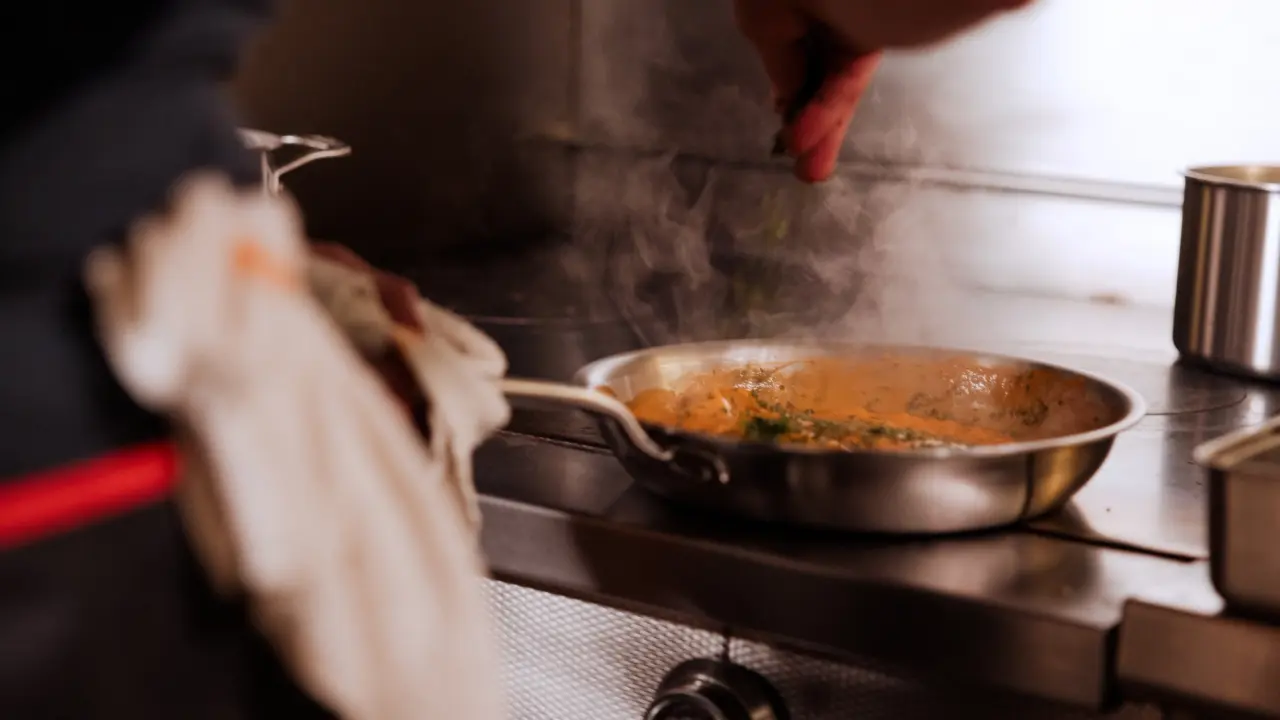There’s a reason stainless steel frying pans are beloved in both home and professional kitchens across the globe. From their unparalleled heat control to their long-lasting durability, these pans excel at all parts of the cooking process, from frying to finishing.
If you don’t have one already, this guide will walk you through every aspect of shopping for a stainless pan so you know exactly what to expect before committing to the purchase. Follow along to find out why these pans are right for you.
What Is Stainless Steel?
Stainless steel is an alloy composed of multiple metals, generally iron, nickel, and chromium. Chromium hardens steel and prevents corrosion, while nickel provides the signature polish and shine of stainless steel.
18/10 stainless steel indicates it’s composed of 18% chromium and 10% nickel, while 18/8 stainless indicates 18% chromium, 8% nickel. The higher nickel content in stainless steel results in a more attractive, high-end grade that’s typically used for flatware and pans (like ours).
What Is Stainless Clad?
Stainless Clad refers to the “cladding” process, where different metals are layered and then bonded together to form a single, new sheet of metal. Our Stainless Clad Cookware is 5-ply, meaning it’s composed of 5 sheets of 4 different metals. The four metals it contains are 18/10 Stainless Steel, aluminum, aluminum alloy, and high-grade ferritic 403.
Our Stainless Clad starts with an aluminum and aluminum alloy core that provides excellent heat conduction capabilities and even heating across the surface of the pan. This core is then enveloped with the 5-ply of different metals. This all results in an incredibly durable, induction-compatible pan that’s corrosion- and rust-resistant, and responsive to heat.
Is Stainless Steel Safe?
Stainless Steel Pans are some of the safest on the market, especially when constructed of high-grade stainless steel like 18/10. Since our Stainless Clad Cookware is nonreactive, this also means you don’t have to worry about chemicals leaching into your food or the metal reacting to acidic ingredients.
If you have more questions or concerns about our Stainless Clad Cookware, check out our dedicated guide to whether Stainless Steel is safe.
What Size Pan Do I Need?

Choosing the right size stainless steel frying pan comes down to what you need from it. Pan sizes vary across brands, but common sizes (from smallest to largest) include 6", 8"-, 10", and 12" options. We cover the differences and what each size is best suited for in our guide to frying pan sizes, but at a glance:
- 6" and 8" Pans are among the smallest options offered, and are designed for single servings of food. These are best suited for a small steak or sautéing vegetables for a side dish or appetizer.
- 10" Pans are best suited for 2–3 servings of food, as these are a great middle ground for cooking without overcrowding the pan. These can comfortably fit 2 large or 3 small chicken breasts or sautéing about a pound of spinach.
- 12" and 14" Pans are typically the largest sizes offered and are ideal for cooking large quantities of food for a crowd. These are excellent choices for cooking a Dutch Baby or a Porterhouse steak.
How to Cook With Stainless Steel Pans
The most important factor to keep in mind when cooking with stainless pans is temperature. Getting these pans properly heated is key for a cooking experience free from stuck-on food.
To ensure your pan is thoroughly preheated, heat it to your desired temperature, then add a few drops of water. If the water “dances” around the pan, it’s ready. If the water stays still it’s not heated enough yet, and if the water evaporates immediately it’s too hot and should be cooled a bit before adding oil and food.
Trusting your pan is also essential when cooking with stainless—the beauty of these pans is that the food releases from the surface when it’s cooked, similar to what occurs during a Maillard reaction. Once you’ve practiced a few times, you’ll easily be able to cook ingredients like skin-on chicken or more delicate cuts of fish.
For more advice, check out our guide to successful cooking with Stainless Steel.
How to Keep Food from Sticking
One of the biggest concerns people have when cooking with stainless pans is their food sticking to the surface and burning. While it’s true these pans don’t have the coated, no-stick surface of non stick pans or the built-up seasoning of carbon steel, keeping food from sticking to the surface of a stainless pan isn’t as fussy as it may seem.
There are a few reasons food sticks to stainless steel pans—and most of them have to do with heat. Too much heat, too little, or placing cold food into a hot pan can all cause the microscopic pores in the metal to expand and then shrink, which causes the food to stick.
To prevent this from happening, you need to regulate the heat as much as possible. Ensuring your food is tempered (at room temperature), the pan is preheated with cooking fat, and not blasting or lowering the temperature drastically when food is added can all ensure properly cooked food instead of a sticky, burnt mess.
What Should I Cook with a Stainless Steel Pan?
Once you’ve perfected cooking with stainless steel, the options of what to cook with it are nearly endless. You can sear a hearty protein like steak, sauté a delicate ingredient like mushrooms, or create a tasty pan sauce with any leftover fond—your options are endless.
There are only a few dishes you should stay away from cooking with stainless. Generally, the more delicate the ingredient, the more difficult it will be to cook. While it’s entirely possible to cook dishes like scrambled eggs or flaky fish in Stainless Steel, you may have a better end result if you use a naturally non-stick pan like carbon steel or non stick.
How to Care for Stainless Steel Pans
Caring for stainless pans is actually very simple. As with other materials, let your cookware cool completely before placing in the sink and clean with mild dish soap and the soft side of a sponge. If you have some tough debris, a rainbow stain, or just need some extra help, use our Make It New Cleaner or Bar Keepers Friend.
To maintain the shine of your stainless frying pan for years to come, here are some additional maintenance tips:
- Do not clean your stainless pan in the dishwasher.
- To avoid water spots, dry your pan immediately after washing with a microfiber cloth.
- If you stack your pans in a drawer or cupboard, place a dish towel, trivet, or cloth napkin between each pan to prevent scratches.
For more ways to keep your pans shiny and at optimal performance for years to come, check out our complete guide to maintaining Stainless Clad Cookware.
How Does Stainless Steel Compare to Other Cookware?

If you already have a variety of other pans, you may wonder what sets stainless steel apart from the others in your kitchen and if it's worth adding to your collection. Here’s how it stacks up, and why we think it’s a must-have.
Aluminum
From an aesthetic standpoint, it can be hard to discern between Stainless Steel and aluminum pans. Both are shiny, silver, metallic pans without a coating—but that’s about where their similarities end. While aluminum is a great heat conductor, pure aluminum pans are cheap to purchase and even cheaper to produce, which results in pans that wear out quickly and need to be replaced often.
Meanwhile, 18/10 stainless steel is extremely durable and can last for years when properly maintained. We highly recommend Stainless Steel over aluminum—it may be more costly upfront, but you won’t have to replace your pan after 2 years. For more information on why we recommend one over the other, check out our guide to Aluminum vs. Stainless Steel Cookware.
Carbon Steel
Since carbon steel pans are described as a combination of the best parts of cast iron and stainless steel, it’s worth wondering if these are both necessary to own. Especially considering the similarities don't stop there—carbon steel and stainless steel are both oven safe, boast incredible heat retention, are induction-compatible, and can handle anything from slow sautés to high-heat sears.
These pans have similar advantages, but that doesn’t mean they can replace one another. We recommend using both these pans as building blocks of your cookware collection, and thinking of them like complements instead of competitors. You can find out more about how these two compare in our guide to carbon steel vs. stainless steel cookware.
Non Stick
Of the materials that stainless steel is compared to, non stick is the one with the least similarities. Non stick has a durable no-stick coating to provide its signature slick surface, while stainless steel has no coating and its cooking surface is the metal itself.
Non stick should be used for more delicate foods, like scrambled eggs or fish, while stainless can handle just about anything else.
You shouldn’t feel like you have to choose between these pans—they serve vastly different purposes in the kitchen. We cover more of them in our guide to non stick vs. stainless steel cookware.
How Much Is a Stainless Steel Frying Pan?

Depending on the construction materials and quality, a stainless steel pan can range anywhere from $50 to upwards of $200 or more. Since these pans last for years with proper maintenance, think of them as an investment piece that will serve you well for many, many meals to come.
Ready to Shop?
Now that you’re equipped with everything you need to know about buying a stainless steel pan, all that’s left to do is actually purchase one.
Our Stainless Clad Pans are what landed us in some of the world’s best kitchens, and once you join the over 16,000 home cooks who have added it to their cookware collection, you’re sure to see why.































